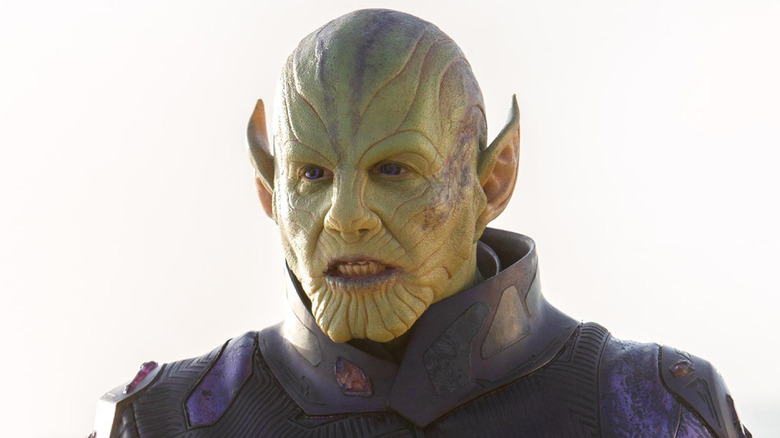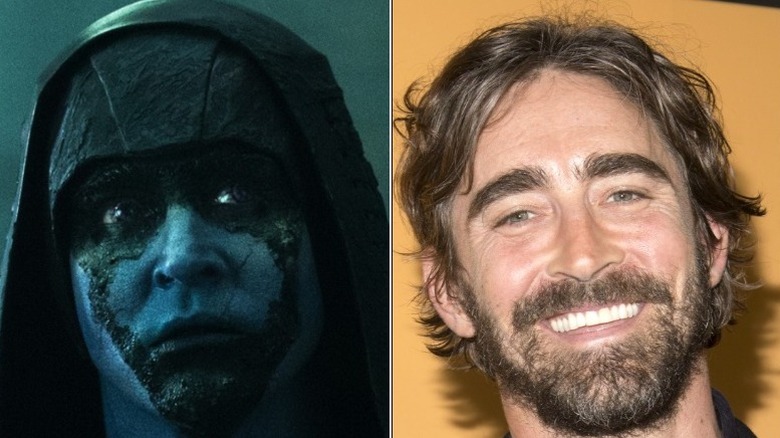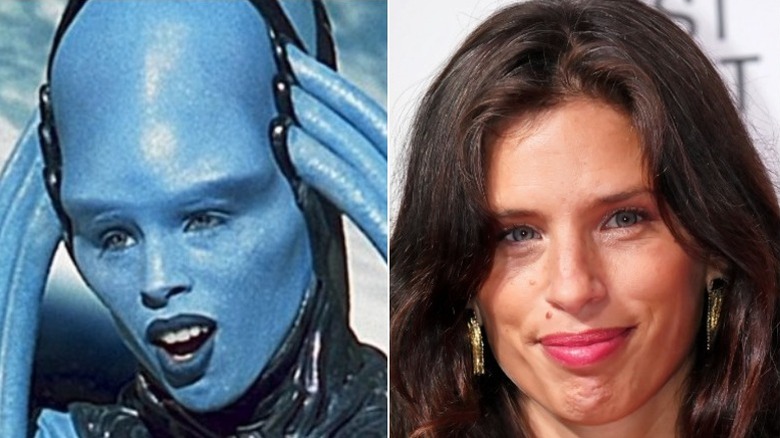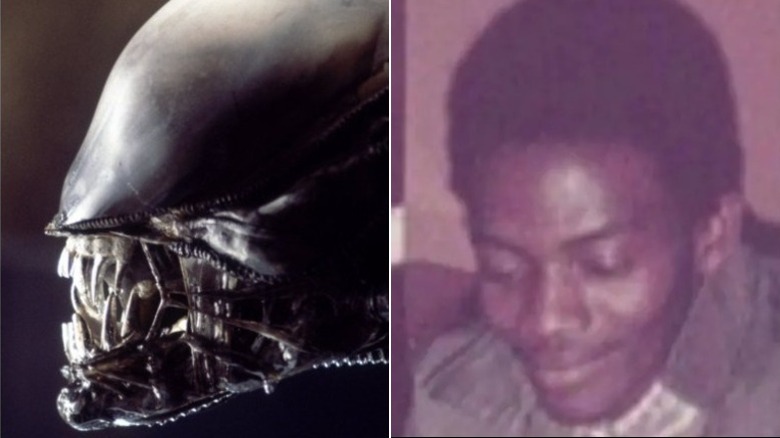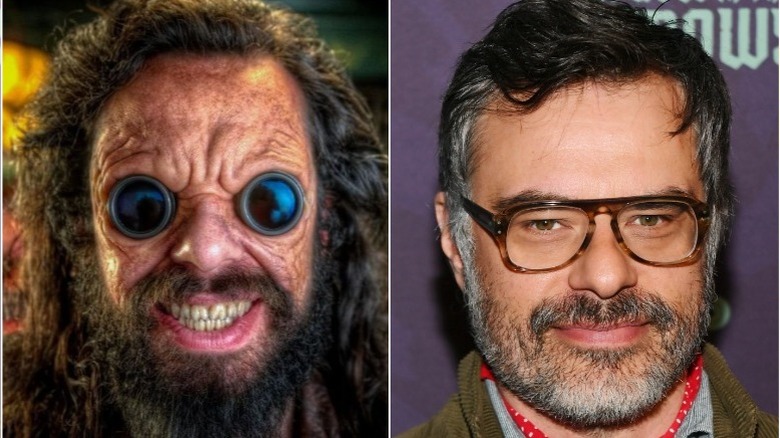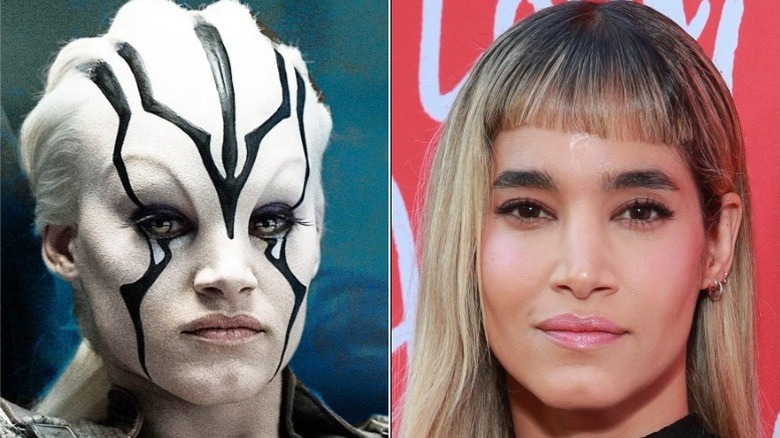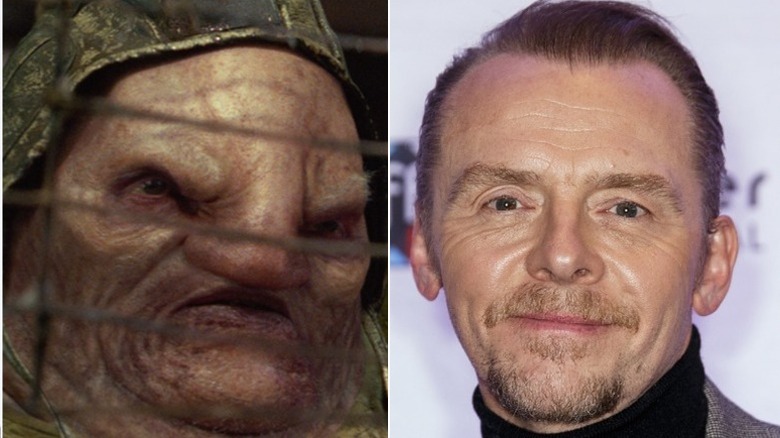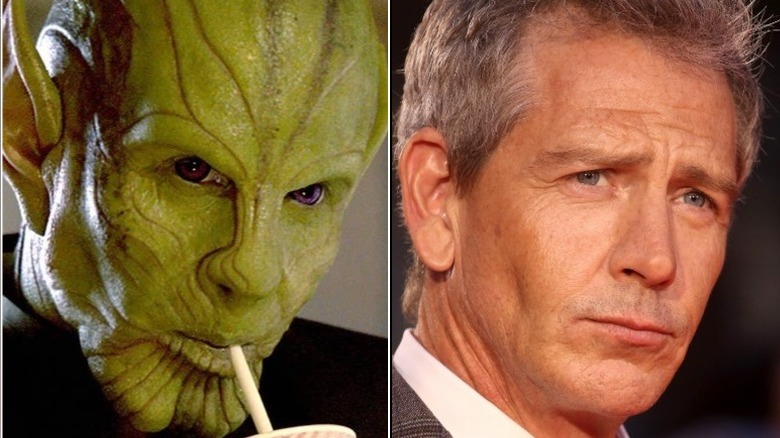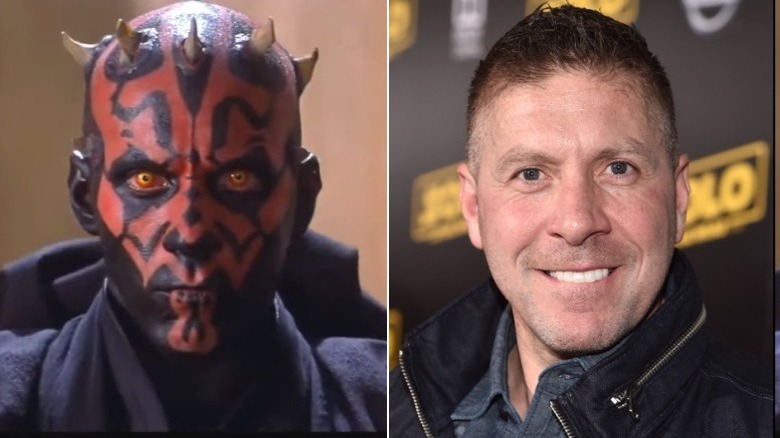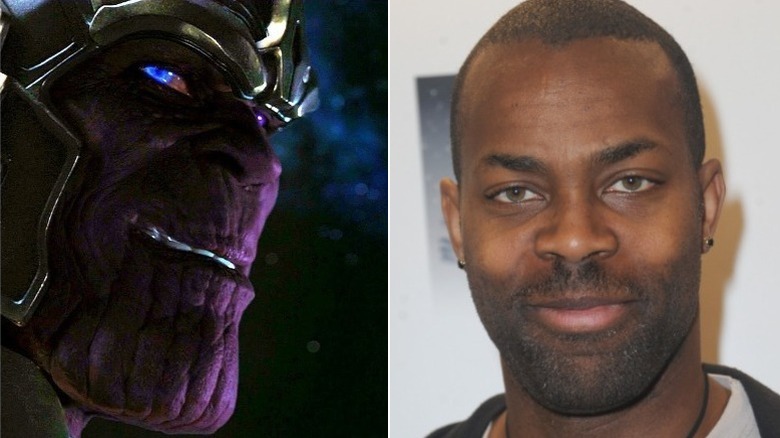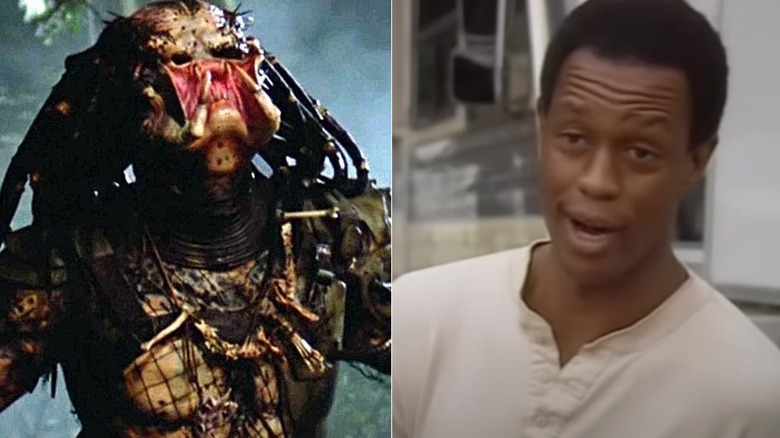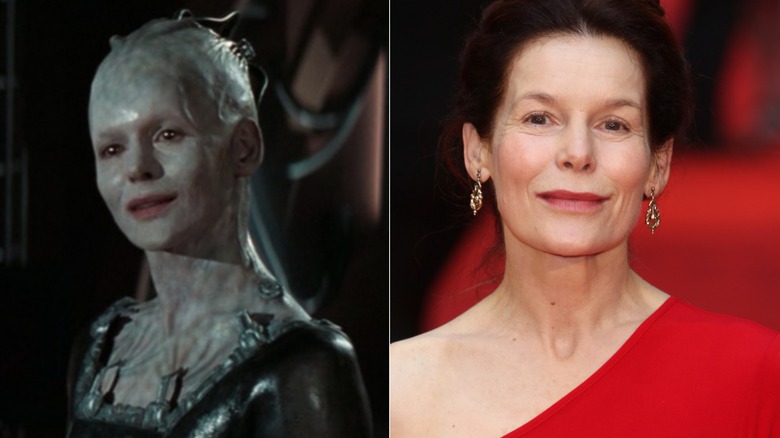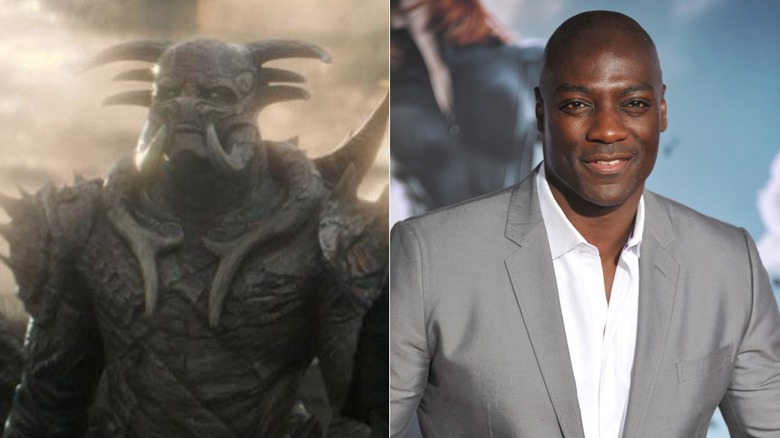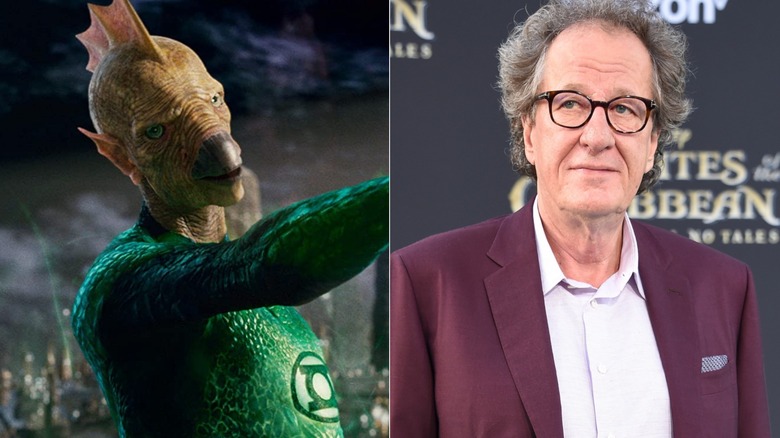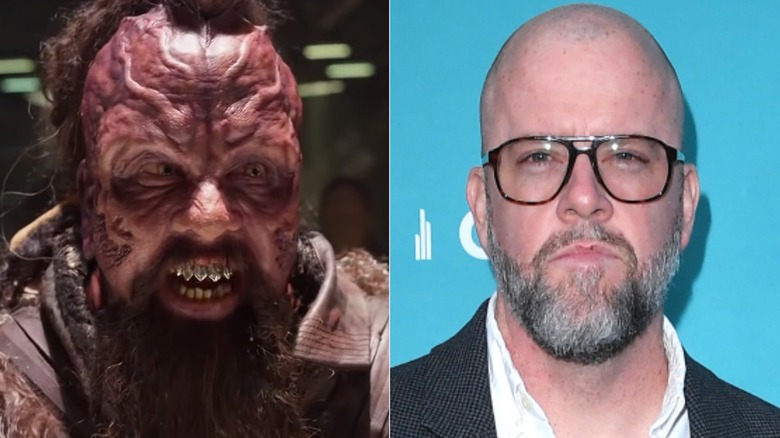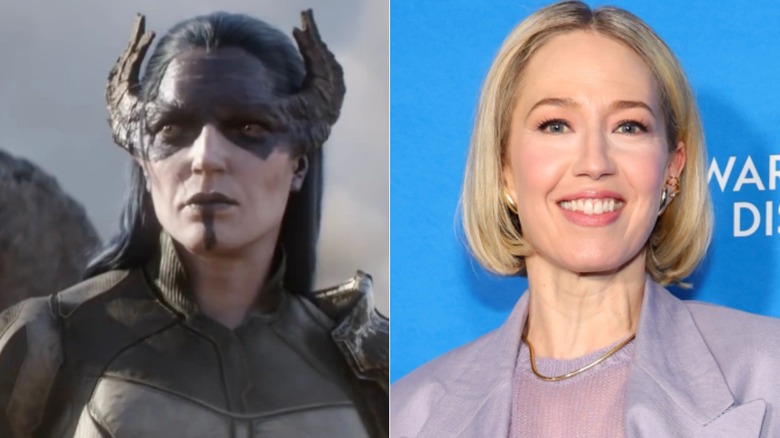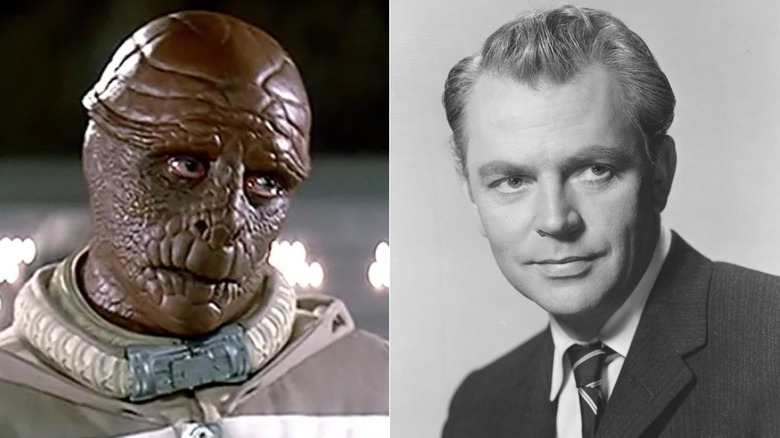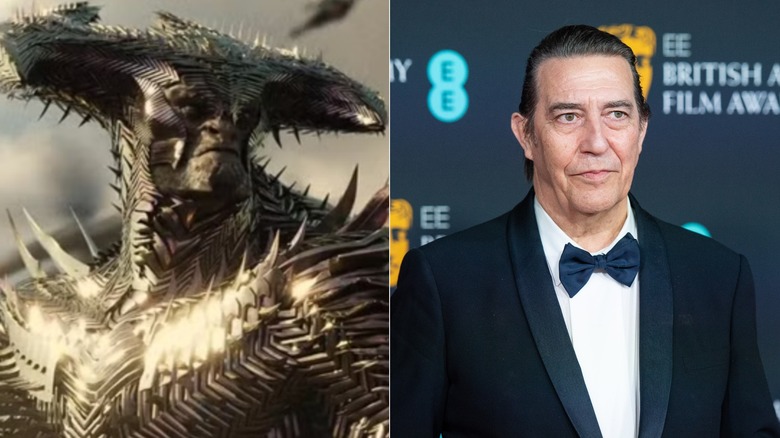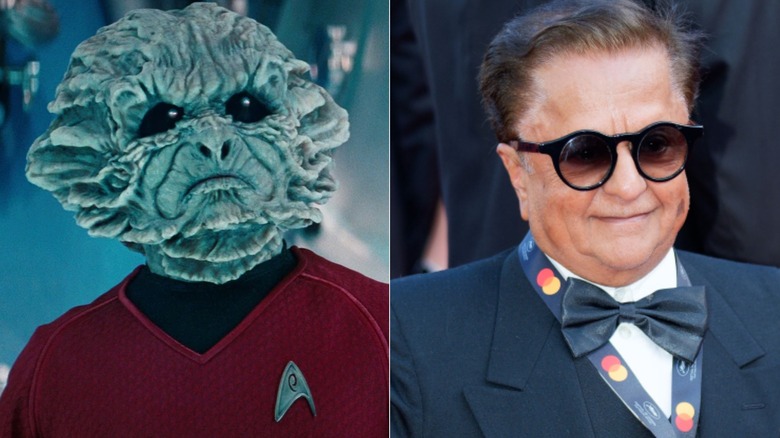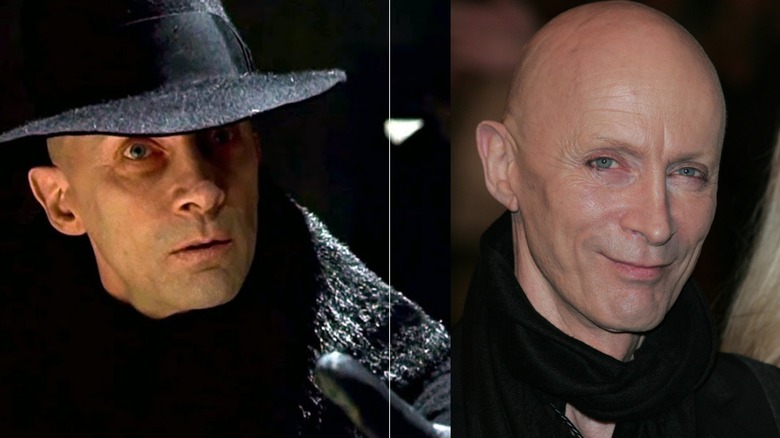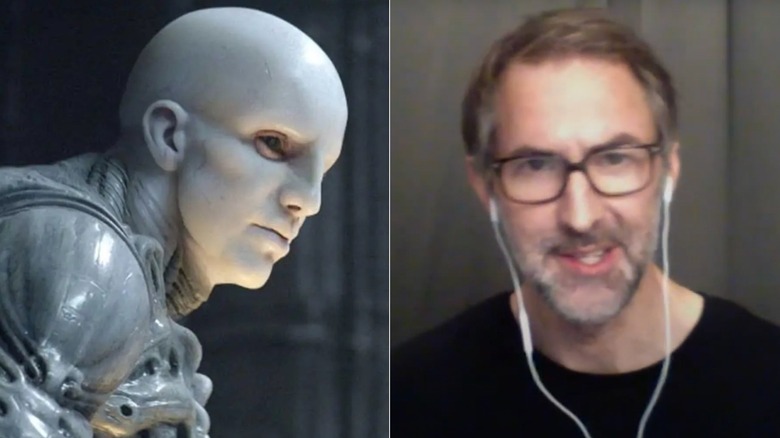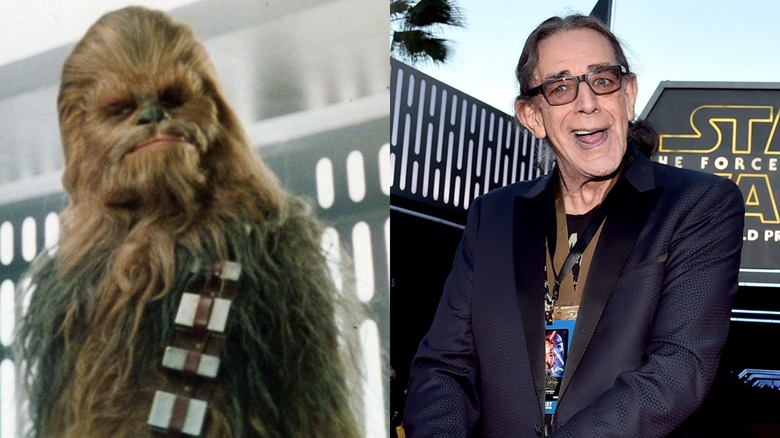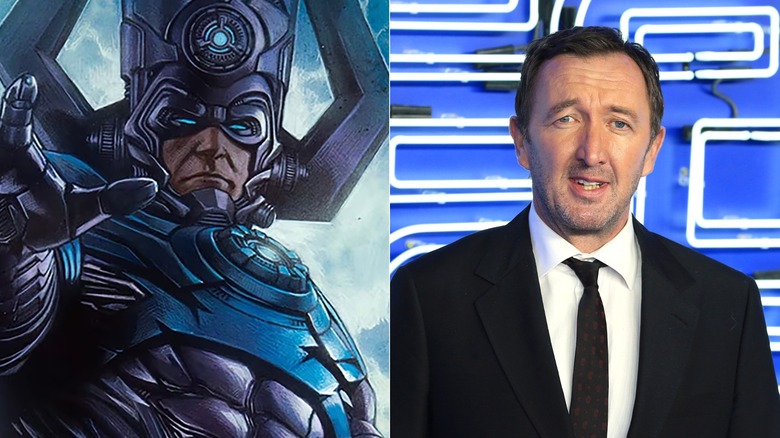What These Movie Aliens Look Like Without Makeup
Makeup is an important part of science fiction and fantasy films, especially when it comes to creating alien characters. While modern blockbusters often rely on computer-generated imagery to bring aliens to life, many high budget movies still turn to the old tradition of cosmetics and prosthetics to design these creatures.
Makeup artists usually spend many hours working to nail every detail of an alien's design, so that they might make these fictional characters feel real to the people watching them. From the color of an alien's skin to the placement of tentacles on its head, the look of an extraterrestrial being in a genre film can make audiences truly see aliens, rather than actors.
Speaking of actors, this makeup magic can turn even the most famous of celebrities into unrecognizable beings. These actors' performances play a major role in cementing the authenticity of their fictional identities and masking their often-iconic faces. We're here to examine just how wide the gulf is between those actors' everyday faces and the alien roles they step into, and to appreciate those makeup artists who transform these actors into otherworldly characters.
Lee Pace as Ronan the Accuser
Lee Pace has appeared in many movies and TV shows over the years, including "The Hobbit: The Desolation of Smaug," "Halt and Catch Fire," and "Foundation." Yet his most high-profile role might be Ronan the Accuser, the alien villain of the 2014 Marvel film "Guardians of the Galaxy," which covered him in makeup from head to toe. In the comics, Ronan is part of the blue-skinned alien species known as the Kree, so makeup artists Elizabeth Yianni-Georgiou and David White painted Pace's body blue and almost entirely shrouded his face in black tar.
While promoting the film, Pace told the YouTube channel ScreenSlam that he loved wearing the extensive makeup because it served as a "mask" for the character. "I move my face in a different way, but what's great about that too is that it's not the way the character looks, it's the way he wants to look," said Pace. "He's got blue skin but on top of that, he's painted this fearsome mask because that's how he wants to present himself to the world." Yianni-Georgiou and White also designed the look for other extraterrestrial characters in the film, which would earn them an Oscar nomination for Best Makeup and Hairstyling in 2015.
As for Pace, he would once again play Ronan in 2019's "Captain Marvel." This time, he performed without black face paint since the movie takes place before "Guardians of the Galaxy" and features a less radicalized version of the character.
Maïwenn as Diva Plavalaguna
French actress Maïwenn Le Besco, known simply as Maïwenn, portrayed the tall and mysterious alien opera singer Diva Plavalaguna in 1997's "The Fifth Element" while wearing all kinds of prosthetic makeup. In a rare interview about her extraterrestrial character, Maïwenn explained that the film's French writer-director Luc Besson, who was engaged to her at the time, offered her the part of Diva. Maïwenn initially passed, saying, "'Oh, thank you, but if I love you, I want to show you my love that is pure, so I don't want to work with you.'" Besson ended up hiring a German model to play Diva, but she did not show up to her makeup test, so he asked Maïwenn to play Diva.
When describing the makeup process for Diva, Maïwenn revealed that it took three hours every day. The team, led by Lois Burwell, applied makeup around Maïwenn's head before they glued Diva's giant prosthetic dome onto her own. They then gave Maïwenn stilts and the dress, which was "very fragile." Since Maïwenn was so tall in her stilts, she required a special chair and her own crew to help her eat and drink.
Diva is arguably Maïwenn's most recognized role, internationally speaking. She is, however, a well-known talent in France, and has gone on to write and direct movies of her own.
Bolaji Badejo as the Alien
Ridley Scott's sci-fi-horror film "Alien," released in 1979, is considered one of the greatest movies of all time. Yet most people may not know that the eponymous creature was actually played by a 6-foot, 10-inch Nigerian man in a rubber suit. Born in 1953, Bolaji Badejo had moved to London in order to specialize in graphic design. One fateful night, casting agent Peter Ardram (sometimes referred to as "Peter Archer") spotted Badejo at a pub and subsequently called Ivor Powell, associate producer of "Alien," to arrange a meeting. Director Ridley Scott picked Badejo to play the titular antagonist because of his tall height, long limbs, and slim figure.
In a 1979 interview with Cinefantastique magazine, Bolaji explained how uncomfortable the Alien suits truly were. Said suits were designed by surrealist artist H.R. Giger, who won an Oscar alongside the film's special effects team. "It was terribly hot, especially the head. I could only have it on for about 15 or 20 minutes at a time. When I took it off, my head would be soaked," Bolaji recounted. Furthermore, the suit blinded him: "I could barely see what was going on around me, except when I was in a stationary position, while they were filming. Then there were a few holes I could look through."
Bolaji did not act again. Sadly, he died from sickle cell anemia in 1992 — but the world will never forget the terrifying movie monster he helped realize.
Jemaine Clement as Boris the Animal
New Zealand-born Jemaine Clement is known for playing comedic roles in movies and TV shows such as "What We Do in the Shadows" and "Flight of the Conchords." But he also played a terrifying alien villain in the 2012 film "Men in Black 3," where he wore plenty of prosthetics and makeup.
"I think the first day we put the makeup on, it took eight hours, so before you even start a workday, you've already had what most people think of as a workday," Clement explained to Rotten Tomatoes. "They gradually got it down to four hours. Now we can do it in three hours, so sometimes I have to get up really early, two or three a.m., and come and sort of be half-asleep or even completely asleep as [they are] gluing things and spraying things onto my face."
Legendary make-up artist Rick Baker, who designed the aliens for "Men in Black 3" and its two predecessors, brought Boris to life and made him scarier than intended. "In the script I got originally, he was a biker but they described him as Dennis Hopper from 'Easy Rider,'" Baker explained to Digital Trends in 2012. "I said, 'You know what? I think he should be intimidating, like Charles Manson or [1960s Hell's Angels president] Sonny Barger ... I did these designs and kind of reinvented what I thought he should be." As viewers know, Baker's vision ultimately prevailed.
Sofia Boutella as Jaylah
Actress, model, and dancer Sofia Boutella played the alien warrior Jaylah in 2016's "Star Trek Beyond" – her first role that involved prosthetic makeup. While promoting the film, Boutella explained to ScreenSlam why she enjoyed the long makeup process. "The meditation aspect of it is like getting into character. You actually take this time. Sometime, you get on set and you have very little time. Hair and makeup, costume, boom, you're on set ... and I appreciated that I could [take my time in the chair]," Boutella said. "I like that second skin. I like what it brought to me. It's like, as soon as I had it on, you feel in character."
Joel Harlow, the makeup designer on "Star Trek Beyond," clarified to Inverse in 2017 why applying makeup to Boutella took longer than applying makeup to Idris Elba, who played the film's similarly inhuman-looking villain, Krall. "It's deceptively elaborate with lots of intricate dissections. The challenge was to strike a balance and blend it to where you don't know where the prosthetics are," said Harlow. "Sofia Boutella wore a forehead that came down her cheeks and black design markings that went all the way down to her chin. The mouth, nose, and chin are Sofia; otherwise, everything else is all a prosthetic." Taking their time was worth it in the end, because Harlow and fellow makeup artist Richard Alonzo received an Oscar nomination for "Star Trek Beyond."
Simon Pegg as Unkar Plutt
In addition to playing Scotty in the rebooted "Star Trek" films, British actor and comedian Simon Pegg portrayed the slimy alien junk dealer Unkar Plutt in 2015's "Star Wars: Episode VII — The Force Awakens."
"So it was a prosthetic that we applied to Simon," the film's creature supervisor Neal Scanlan detailed in a 2016 interview with Nerdist. But it wasn't all practical effects work: "I think they did a little bit of CG enhancement on the inside of the mouth as well," Scanlan added, "to give him a slightly wider gape in his mouth than what you could do in real life ... it would have just been Simon's mouth otherwise." Even though some CGI was used to bring Plutt to life, it was definitely not as much as what was used for Lupita Nyong'o's Maz Kanata and Andy Serkis' Supreme Leader Snoke. This successful blend of CGI and practical effects is why Scanlan and the film's special effects team earned an Academy Award nomination.
On the flip side, Pegg didn't find the suit all that comfortable, as he explained on a 2018 episode of "The Graham Norton Show." "I was wearing that in 50 degree heat and I had these big rubber-like silicone gauntlets on my fingers," said Pegg. "And when I took them off I could pour the sweat out." At least he only had to wear the suit for three scenes, excluding the deleted scene where Chewbacca rips one of his arms off.
Ben Mendelsohn as Talos
Australian actor Ben Mendelsohn has played many villains throughout his career. But his turn as the alien Talos in 2019's "Captain Marvel" is one of the few roles for which he wore prosthetics and makeup — plus, as it turns out, Talos isn't actually the villain. Talos is a Skrull, green, shapeshifting aliens often portrayed in the comics as evil. Halfway through "Captain Marvel," however, Talos' faction of Skrulls are revealed as fugitives from the Kree Empire, who destroyed their home world.
To throw audiences off, Legacy Effects supervisor Shane Mahan made the film's Skrulls look intimidating and pretty similar to how they look in the comics. Although Mendelsohn does show his human face a few times throughout "Captain Marvel," he spends most of the movie in makeup. Mendelsohn told Entertainment Weekly that the makeup process only took "a couple of hours." When asked if the makeup team managed to quicken the process at all, Mendelsohn replied, "They have ... They're awesome. It's a couple of hours. It's not that big a deal, you know?"
Mendelsohn donned the makeup once again in "Spider-Man: Far From Home" and "Secret Invasion," so good thing he has no problems with kicking back for a handful of hours in the makeup chair.
Ray Park as Darth Maul
Scottish stuntman Ray Park wore plenty of makeup when he portrayed the acrobatic Sith Lord Darth Maul in 1999's "Star Wars: Episode I — The Phantom Menace." The film's principal makeup artist, Paul Engelen, spoke about Maul's devilish look in a 1999 issue of Make-Up Artist magazine (via TheForce.net).
"The red I used was actually a water-base aquacolor that would fade but it was quite easy to reapply by sponging on," Engelen detailed. "The black was Reel tattoo color, which I had to paint on. It's kind of elasticized so would tend to peel rather than run. I sponged it on with a fairly heavily saturated alcohol-based sponge and a lot of black pigment ... Even with all of the action scenes shot out there, it worked."
Park revealed to Syfy Wire in 2019 that he was initially unsure about the makeup. "When they were doing me up, I just thought I looked silly," he recalled. "You know, my big nose, and my weird teeth, and then my blue eyes, and I just felt like a big panda, you know? ... But once the contact lenses were in and people were staring at me on set, it was like, 'Wow.'" Park reprised his role for a cameo in 2018's "Solo: A Star Wars Story," provided motion capture for Maul in "The Phantom Apprentice" episode of the animated series "Star Wars: The Clone Wars" and was seen via archival footage in the Disney+ series "Obi-Wan Kenobi."
Damion Poitier as Thanos
Before Josh Brolin wore a motion capture suit to play Thanos in the Marvel Cinematic Universe, American actor and stuntman Damion Poitier wore prosthetic makeup while portraying the Mad Titan in a mid-credits stinger in 2012's "The Avengers." Flash forward to 2014, when Poitier explained to the Geeks with Wives podcast how he discovered which character he would play. "I found out when I was in the makeup chair what I was doing," said Poitier. "They kept it super quiet because they didn't want to put any spoilers out ... I didn't find out until they were casting my face to do the sculpt." Although Poitier would not play Thanos again, he did play Hero Merc #1 in 2016's "Captain America: Civil War."
In 2018, costume and creature design powerhouse Ironhead Studio, led by Jose Fernandez, shared a behind-the-scene photo on their Instagram of Poitier wearing the Thanos makeup and prosthetics on "The Avengers" set in 2011. As the caption details, "Although Thanos ended up getting a digital sheen for the film and eventually became fully digitally rendered in "Avengers: Infinity War," Jose still has a soft spot for this practical makeup design." While the practical Thanos makeup was not used in later Marvel movies, Ironhead did design costumes for "Captain America: Civil War," as well as other high-profile movies and TV shows such as "Aquaman" and "The Mandalorian."
Elizabeth Debicki as Ayesha
Australian actress Elizabeth Debicki has starred in many high-profile movies and TV shows throughout her career. But her turn as the alien queen Ayesha in 2017's "Guardians of the Galaxy Vol. 2" is definitely the only role she's played that required her entire body to be painted gold. While promoting the film, Debicki spoke to Comicbook.com about putting on the makeup. "It was like a car wash," she recalled. "They built a sort of car wash where I sat ... there was a lot of paint and a lot of sitting around and drying. It's quite an intimate process."
The film's head of makeup, John Blake, also spoke to Make-Up Artist magazine about giving Ayesha's species, the Sovereign, their gold look. "I wanted to get a nice-looking gold," said Blake, "which is more difficult than it sounds ... it was just a matter of mixing batch after batch of different materials before I could come up with a gold that had the right amount of softness and metallic gleam to it. It [also] had to stay on, but was easy to get off." In the end, Blake and the makeup team succeeded in giving the Sovereign a bright gold look that makes them stand out from everyone else in the movie.
Kevin Peter Hall as the Predator
The late 1980s are home to some of the best cinematic blends of action and sci-fi, from 1986's "Aliens" to 1988's "RoboCop," and sandwiched in between is the 1987 Arnold Schwarzenegger classic, "Predator." But while the former bodybuilder gets all the attention in the starring role as alien-hunting paramilitary macho man Dutch Schaefer, the man behind the iconic alien monster's makeup is equally deserving: stuntman Kevin Peter Hall. In addition to the Predator, he also portrayed the Bigfoot in "Harry and the Hendersons," Big John in "Big Top Pee-Wee," and a Klingon in an episode of "Star Trek: The Next Generation."
"People know me because I play the monsters, but I'm most recognized from the small roles in which they see my face," Hall told Starlog magazine back in 1990. "None of that stuff really bothers me. Whether I'm recognized in or out of a costume isn't a kind of pressure I put myself through anymore." Beneath the makeup and heavy prosthetics, Hall was a dashing figure of a man, but it wasn't his good looks that got him work; it was instead his imposing stature, as he stood an eye-popping 7 feet, 2 inches tall, making him the perfect actor to embody a monster capable of striking fear into the heart of the mountainous Arnold Schwarzenegger. Tragically, Hall lost his life to AIDS in 1991, just a year after making "Predator 2."
Alice Krige as the Borg Queen
"Star Trek: First Contact" retconned the Borg Collective to have a singular leader: the Borg Queen, played by Alice Krige. In the film, Krige's transformation into the Borg Queen is a nightmare: she's decked out in gray body paint, stripped of her hair, and wearing a bodysuit that's seemingly attached to her, giving her the appearance of a half-woman, half-robot alien monster.
The heavy makeup and costuming made the shoot difficult, according to the actor, especially when it came to using the bathroom. "It took me 45 minutes to get out [of the costume], then 45 minutes to get me back in it, and the whole crew sat there with their hands folded while I peed," she told Starlog in 1997 (via Trekkie Feminist). Worse yet, to minimize breaks, Krige opted to drink less. "It was a disturbing enough experience for me not to want to do that again, so I didn't drink very much after that."
Despite the challenges, Krige says the impressive costume and makeup allowed her to easily slip into the character of the insidious Borg Queen. "I was overwhelmed with gratitude for what they had all done, and how well it had been conceived. I certainly wanted to try to accomplish a character that was at once attractive and repulsive and frightening, yet you were obliged to look at her." Krige returned to play the character in 2024, lending her voice for an episode of "Star Trek: Picard" where her physical form was played by another actor.
Adewale Akinnuoye-Agbaje as Kurse/Algrim
"Thor: The Dark World" may rank as one of the worst MCU movies of all time, but when it comes to the design of its villains, it might be among the very best. While Christopher Eccleston's Malekith often gets credit as the movie's best-looking baddie, Adewale Akinnuoye-Agbaje as Algrim (and Kurse) might be even better. The "Lost" alum donned makeup and prosthetics to play the Dark Elf known as Algrim the Strong, who is eventually transformed into the monster called Kurse.
Commenting on the prosthetics required to become the two different versions of his character, Akinnuoye-Agbaje told Collider that he didn't even know how he was going to look until they screened the film. According to the actor, the complete visual was pieced together in post-production. "There is pieces, you know, the hair pieces, the face, so you don't see any of it in its entirety until pretty much towards the end," he said. "It's a journey and it's a revelation when you actually see it."
As for the costume and makeup itself, Akinnuoye-Agbaje was forced to wear a 30-plus pound bodysuit as well as a fiberglass body cast. To get into character, he spent a lot of time in the mirror. "I found that less was actually more with him because the bulk actually said a lot and certain movements," the actor explained. "It's very flexible, the mask that they put on, so every grimace and wink you can see." Ironically, acting as Kurse actually helped improve the actor's posture, thanks to the way the costume forced him to walk on-set.
Geoffrey Rush as Tomar Re
Three DC cinematic universes ago, "Green Lantern" introduced us to a world of superheroes in 2011, headlined by Ryan Reynolds, Blake Lively, and Peter Saarsgard. The film was a box office bomb that killed the studio's first attempt at a DC movie-verse, and a lot of the blame has been laid on the weird CGI. The visuals were used to awkward effect on Reynolds himself, whose entire superhero outfit was CGI. Still, when used for its alien characters — like Kilowog (Michael Clarke Duncan) and Abin Sur (Temuera Morrison) — the digital makeup wasn't as bad. That was perhaps because, as is the case with actor Geoffrey Rush and his character Tomar Re, there was no motion capture.
"I was absolutely, exclusively putting down my voice tracks," Rush told ScreenRant. Curiously, to voice the character, Rush looked to his previous roles as Leon Trotsky in "Frida" and Sir Francis Walsingham in "Elizabeth." "You could say that I've mentored Queen Elizabeth I as Walsingham, and Trotsky has mentored Frida Kahlo, and now Tomar Re is going to mentor Hal Jordan," he noted.
Rush, of course, is a decades-long veteran of stage and screen and has appeared in the "Pirates of the Caribbean" films as Captain Barbossa and dramas like "The King's Speech," "Shakespeare in Love," and "Shine," all of which earned him Academy Award nominations — while the latter won him the coveted trophy.
Chris Sullivan as Taserface
The "Guardians of the Galaxy" films changed the face of the Marvel Cinematic Universe, exploring the larger cosmos of the MCU and alien races like the Kree. A fan-favorite alien adversary first featured in "Guardians of the Galaxy Vol. 2" is Taserface, whose look conjures up alien nasties from "Men in Black."
"The makeup process started off at about three-and-a-half hours and we whittled it down to about two-and-a-half, as the makeup team got more and more practiced at it," Sullivan told Entertainment Weekly. "It was quite involved," he said, but noted that it wasn't all bad; he had company to keep him entertained while waiting to be prepped for his role.
"Every morning, bright and early, I shared a makeup trailer with Michael Rooker. So, it was he and I sitting next to each other, getting ready for work, and sharing stories of our lives! Michael Rooker is like the Merle Haggard of the acting world. Never a dull moment. Never a dull story." Sullivan later returned to play TaserFace in an episode of the Disney+ series "What If...?," and because of that show's animated nature, he didn't have to deal with the makeup — which meant no sharing a trailer with Rooker, and no more fun early morning stories.
Carrie Coon as Proxima Midnight
"Avengers: Infinity War" had more characters than fans could count, including plenty of newly-introduced ones. Among those newcomers was Proxima Midnight, the vicious leader of the Black Order and the primary henchman for the cosmic despot Thanos (Josh Brolin). A gray and blue-faced alien with a wicked grin and a devilish look in her eye, Proxima Midnight might be the scariest of Thanos' warriors. But beneath it all is actor Carrie Coon, better known today for her role as Laurie in Season 3 of "The White Lotus."
Recruited to play the villainous Proxima Midnight, Coon's role was brought to life mostly with motion capture. Early in her career, Coon had performed mo-cap for video games, and knew what she was getting into, but it wasn't exactly what she expected. "It was a very different experience. I was also pregnant when I did it," she told Entertainment Weekly in 2018. "I flew down to Atlanta and did some mo-cap, mostly the facial capture."
Though Coon is responsbile for all of the acting and voice work, she is also quick to credit her digital collaborators. "I can't take credit for all of it — it's a gifted team of animators that are taking on the bulk of that performance. But it morphed from a voiceover job into a mo-cap job, and then suddenly I realized I was in the highest-grossing movie of the year."
Dan O'Herlihy as Grig
A cult classic from the early 1980s, "The Last Starfighter" was an obvious attempt to cash in on the popularity of "Star Wars." While there have been plenty of weird "Star Wars" rip-offs, "The Last Starfighter" wasn't one of them; it was a legitimately exciting, well-produced sci-fi adventure for the whole family, about a teenage boy brought into outer space to help fight an interstellar war.
Hollywood veteran Dan O'Herlihy plays the Obi-Wan-like alien mentor, Grig. In his 60s when he filmed "The Last Starfighter," O'Herlihy was a Hollywood leading man for decades. During his heyday, O'Herlihy appeared in dozens of films, including classics like Orson Welles' "Macbeth," "Robinson Crusoe" (for which he was an Oscar nominee) and "The Virgin Queen" with Bette Davis. By the 1980s, O'Herlihy was still a well-known name, even if he wasn't a big star. Along with Robert Preston, who played the alien Centauri, O'Herlihy was the veteran stage actor who brought credibility, not unlike Alec Guinness in "Star Wars."
Of course, modern audiences probably remember him best for his role as the CEO of OmniCorp in the first two "RoboCop" films. Among his final roles was a 1994 episode of "Batman: The Animated Series," where he again played a wealthy, villainous CEO, this time the power-mad Grant Walker.
Ciaran Hinds as Stepponwolf
The second DC cinematic universe, affectionately referred to by its most ardent supporters as the so-called "Snyderverse," boasted an impressive cast of stars. While Henry Cavill, Gal Gadot, and Ben Affleck headlined the DCEU's stable of heroes, its villains were portrayed by some pretty heavy hitters, too, from Michael Shannon to Jared Leto to Margot Robbie. In "Justice League," the big bad — Steppenwolf, the New God and herald of the space tyrant Darkseid — was played by Ciarán Hinds, veteran of such hits as "Rome" and "Game of Thrones" on television, as well as critically acclaimed films like "Munich" and "There Will Be Blood."
Draped in CGI, Hinds mostly performed motion capture for the role, donning a skin-tight mo-cap suit that he described as "tight and embarrassing" in an interview with the Independent. The CGI was indeed impressive — with the second version seen in Zack Snyder's director's cut getting even higher marks from fans. Still, it's an odd choice to use so much digital makeup for the character, mostly because Hinds — with his ability to intimidate with a glaring stare and a frightening frown — might be even more imposing on his own than as a digital creation.
Deep Roy as Keenser
J.J. Abrams' reboot of "Star Trek" in 2009 saw him resurrect the likes of Captain Kirk, Mr. Spock, Dr. McCoy, Lt. Uhura, and Mr. Scott. But that doesn't mean there weren't a few original characters created just for the new films. One of the more prominent ones is the diminutive mechanic known as Keenser, an alien assistant of sorts to Scotty (Simon Pegg) the engineer. The actor who played him is Deep Roy, no stranger to parts that required heavy prosthetics, having appeared as aliens in everything from "Doctor Who" to "The X-Files." He even played the piano-playing Droopy McCool in "Star Wars: Episode VI — Return of the Jedi."
As for the process of getting into the makeup to play Keenser, Roy says it actually evolved over the course of the first two "Trek" reboot movies. "The first film, there were two people making me up. It took them about two hours," he told StarTrek.com. "On the second film, it started with two people and was reduced to one guy, and it took an hour and 45 minutes." Some 15 years after Alice Krige's experience on "Star Trek: First Contact," however, it seems prosthetic technology hadn't made eating and drinking any easier. "When people design these masks they never think that one has to eat," added Roy. "They forgot about that. So I was on a liquid diet."
Richard O'Brien as Mr. Hand
Though it's "The Matrix" that gets the glory, it's "Dark City" that might be the best neo-noir sci-fi film from the '90s. An underappreciated classic, "Dark City" sees Rufus Sewell investigating strange phenomena that reveal a sinister alien conspiracy. The primary antagonists are the Strangers, a group of elusive and enigmatic figures with odd names like Mr. Book (Ian Richardson), Mr. Wall (Bruce Spence), and Mr. Sleep (Satya Gumbert). The Strangers are made up to appear gaunt, pale, and stoic, eyes often hidden beneath the brim of a wide black hat.
Richard O'Brien plays one of those Strangers, the eerily frightening Mr. Hand. Of course, outside of the costume and pallid makeup, O'Brien is ... almost identical. With a unique physical appearance — and notably sharp features — O'Brien has often found himself in roles that require him to be creepy. Most famously, O'Brien co-starred in "The Rocky Horror Picture Show" (which he also wrote) as Riff Raff — the unsettling, Igor-like hunchback assistant to Tim Curry's Frank N. Furter. He's also shown up in the "Rocky Horror" follow-up "Shock Treatment" (a rare sequel to a box office bomb), "Flash Gordon," and others.
More recently, O'Brien has also leveraged the power of his voice, with regular roles on "Phineas and Ferb," while also appearing in the podcast miniseries "The Barren Author."
Ian Whyte as The Engineer
In 2012, director Ridley Scott returned to the franchise he'd helped create more than three decades earlier, helming the "Alien" prequel "Prometheus." Set long before the events of the first movie, "Prometheus" explored the hitherto untold origins of the Xenomorphs and their mysterious creators known as the Engineers. They're depicted as tall, alabaster-skinned, human-like beings, the same race we knew previously as the 'Space Jockey' in the 1979 original. But the Engineers in "Prometheus" weren't CGI or motion-capture, they were actors under elaborate makeup and prosthetics — with Ian Whyte portraying the most prominent of the bunch.
Whyte, whose seven-foot-plus frame made him ideal for the part, was decked out in a muscle suit and bald cap and had his entire body painted white. In some scenes he was also adorned with an elaborate alien space suit. Despite the way it may sound, the costume likely wasn't the most complicated makeup process he'd ever been through: Prior to "Prometheus," Whyte had also portrayed a Predator in "Alien vs. Predator," not to mention giant characters in other franchises like "Game of Thrones," "Harry Potter," and more recently, an episode of the "Star Wars" spin-off, "Andor."
Peter Mayhew as Chewbacca
Among the most recognizable characters in all of science fiction cinema, Chewbacca stands tall — just as he does in real life, with the actor who plays him, Peter Mayhew, measuring in at 7 feet, 3 inches in height. But many fans may not even recognize him. That's because Mayhew didn't do much on-screen acting in his career, rarely sat for on-camera interviews, and unless you were a diehard fanboy attending conventions where he often signed autographs, you might never have seen what he looks like outside of the furry costume.
As for the experience of playing Chewbacca, Mayhew never seemed to complain much about what it was like wearing the character's trademark fur. Before his death in 2019, the actor posted an AMA on Reddit and quite a few of the questions were about Chewbacca's costume and Mayhew's makeup. Asked if it was itchy, Mayhew said, "Yes, but I had an under suit that stopped a lot of the itching." Interestingly, he noted that his undersuit was dyed pink so it would "stand out in the laundry," while adding that a lot of the itchy hairs actually came from shaving his co-star, Carrie Fisher. Don't ask.
Responding to another question, Mayhew did acknowledge that the suit was extremely hot, and he passed out on one occasion while filming "The Empire Strikes Back." Sadly, he lamented that the producers "were more interested in the 3PO suit on my back being dented" than with his health.
Ralph Ineson as Galactus
In 2007, "Fantastic Four: Rise of the Silver Surfer" served as the cinematic debut of one of Marvel's most popular villains — the world-devouring Galactus. Unfortunately, it was anything but impressive, as the character was reimagined as a giant cloud. Flash forward nearly two decades and Marvel Studios has finally done the character right, employing "Game of Thrones" and "Harry Potter" alum Ralph Ineson to play the gargantuan planet-eater in "The Fantastic Four: First Steps."
Decked out in a comic-accurate armored costume and standing hundreds if not thousands of feet tall onscreen, Ineson's version of Galactus was surprisingly not achieved through purely digital trickery. According to the film's director, Matt Shakman, having Ineson on set as the character, in a physical costume, was important for the film's authenticity. "I didn't want to just use motion-capture for Galactus, I wanted to actually have someone there embodying the part," Shakman told Entertainment Weekly. "So we've built an entire costume for him, and we've done a lot of photography testing to figure out — how do you make sure that the scale is correct? How do you film Mount Rushmore?"
While it's hard to say whether Galactus' portrayal in "First Steps" is definitive, he's still a far cry from a big cloud – important for a villain who might be more terrifying than Thanos.
